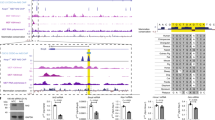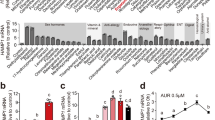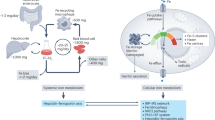Abstract
The defensin-like circulatory peptide hepcidin is the iron-regulatory hormone that links innate immunity and iron metabolism. In response to inflammatory stimuli, the liver produces hepcidin: this antimicrobial peptide then limits the iron that is vital to invading pathogens, by decreasing iron release/transfer from enterocytes and macrophages and causing secondary hypoferremia. This may lead, however, to reduced iron availability for erythropoiesis and therefore to anemia (and anemia of chronic disease). When iron is scarce, the rate at which it is released into the bloodstream must be enhanced: indeed, iron starvation and hypoxia readily abrogate hepcidin expression. Conversely, if excess iron enters the circulation, hepcidin transcription is turned on and iron release from the intestine and macrophages abrogated. Circumstantial evidence indicates that the effect of circulatory iron on hepcidin requires functional HFE and hemojuvelin, two proteins of unknown function that have recently been linked to human hereditary hemochromatosis. In this disease it is likely that inadequate levels of circulating hepcidin lead to the uncontrolled release of iron from the intestine and macrophages, followed by tissue iron overload and organ damage. Given its role as the iron-regulatory hormone, the modulation of hepcidin activity using agonists or antagonists might offer new treatment opportunities in different human iron-dependent disorders.
This is a preview of subscription content, access via your institution
Access options
Subscribe to this journal
Receive 12 print issues and online access
$209.00 per year
only $17.42 per issue
Buy this article
- Purchase on Springer Link
- Instant access to full article PDF
Prices may be subject to local taxes which are calculated during checkout

Similar content being viewed by others
References
Cairo G and Pietrangelo A (2000) Iron regulatory proteins in pathobiology. Biochem J 352: 241–250
Bothwell TH (1995) Overview and mechanisms of iron regulation. Nutr Rev 53: 237–245
Finch C (1994) Regulators of iron balance in humans. Blood 84: 1697–1702
Andrews NC (2000) Iron homeostasis: insights from genetics and animal models. Nat Rev Genet 1: 208–217
Krause A et al. (2000) LEAP-1, a novel highly disulfide-bonded human peptide, exhibits antimicrobial activity. FEBS Lett 480: 147–150
Park CH et al. (2001) Hepcidin, a urinary antimicrobial peptide synthesized in the liver. J Biol Chem 276: 7806–7810
Pigeon C et al. (2001) A new mouse liver-specific gene, encoding a protein homologous to human antimicrobial peptide hepcidin, is overexpressed during iron overload. J Biol Chem 276: 7811–7819
Nicolas G et al. (2001) Lack of hepcidin gene expression and severe tissue iron overload in upstream stimulatory factor 2 (USF2) knockout mice. Proc Natl Acad Sci USA 98: 8780–8785
Hunter HN et al. (2002) The solution structure of human hepcidin, a peptide-hormone with antimicrobial activity that is involved in iron uptake and hereditary hemochromatosis. J Biol Chem 277: 37597–37603
Courselaud B et al. (2002) C/EBPalpha regulates hepatic transcription of hepcidin, an antimicrobial peptide and regulator of iron metabolism. Cross-talk between C/EBP pathway and iron metabolism. J Biol Chem 277: 41163–41170
Nicolas G et al. (2002) Severe iron deficiency anemia in transgenic mice expressing liver hepcidin. Proc Natl Acad Sci USA 99: 4596–4601
Laftah AH et al. (2004) Effect of hepcidin on intestinal iron absorption in mice. Blood 103: 3940–3944
Frazer DM et al. (2002) Hepcidin expression inversely correlates with the expression of duodenal iron transporters and iron absorption in rats. Gastroenterology 123: 835–844
Mok H et al. (2004) Disruption of ferroportin 1 regulation causes dynamic alterations in iron homeostasis and erythropoiesis in polycythaemia mice. Development 131: 1859–1868
Pietrangelo A (2004) The ferroportin disease. Blood Cells Mol Dis 32: 131–138
Nicolas G et al. (2002) The gene encoding the iron regulatory peptide hepcidin is regulated by anemia, hypoxia, and inflammation. J Clin Invest 110: 1037–1044
Nemeth E et al. (2003) Hepcidin, a putative mediator of anemia of inflammation, is a type II acute-phase protein. Blood 101: 2461–2463
Nemeth E et al. (2004) IL-6 mediates hypoferremia of inflammation by inducing the synthesis of the iron regulatory hormone hepcidin. J Clin Invest 113: 1271–1276
Lee P et al. (2004) The IL-6- and lipopolysaccharide-induced transcription of hepcidin in HFE-, transferrin receptor 2-, and beta2-microglobulin-deficient hepatocytes. Proc Natl Acad Sci USA 101: 9263–9265
Roy CN et al. (2004) An Hfe-dependent pathway mediates hyposideremia in response to lipopolysaccharide-induced inflammation in mice. Nat Genet 36: 481–485
Frazer DM et al. (2004) Increased hepcidin expression and hypoferraemia associated with an acute phase response are not affected by inactivation of HFE. Br J Haematol 126: 434–436
Bridle KR et al. (2003) Disrupted hepcidin regulation in HFE-associated haemochromatosis and the liver as a regulator of body iron homoeostasis. Lancet 361: 669–673
Gehrke SG et al. (2003) Expression of hepcidin in hereditary hemochromatosis: evidence for a regulation in response to serum transferrin saturation and non-transferrin-bound iron. Blood 102: 371–376
Bothwell TH (1968) The control of iron absorption. Br J Haematol 14: 453–456
Peters TJ et al. (1988) Mechanisms and regulation of intestinal iron absorption. Ann N Y Acad Sci 526: 141–147
Laftah AH et al. (2003) Hypoxic response of iron absorption is not affected by the Hfe gene knock-out in mice. Br J Haematol 123: 170–172
Wang GL and Semenza GL (1996) Molecular basis of hypoxia-induced erythropoietin expression. Curr Opin Hematol 3: 156–62
Nicolas G et al. (2002) Hepcidin, a new iron regulatory peptide. Blood Cells Mol Dis 29: 327–335
Weinstein DA et al. (2002) Inappropriate expression of hepcidin is associated with iron refractory anemia: implications for the anemia of chronic disease. Blood 100: 3776–3781
Adamsky K et al. (2004) Decreased hepcidin mRNA expression in thalassemic mice. Br J Haematol 124: 123–124
Cartwright GE (1966) The anemia of chronic disorders. Semin Hematol 3: 351–375
Roy CN et al. (2003) 2002 E. Mead Johnson Award for Research in Pediatrics Lecture: the molecular biology of the anemia of chronic disease: a hypothesis. Pediatr Res 53: 507–512
Fleming RE and Sly WS (2001) Hepcidin: a putative iron-regulatory hormone relevant to hereditary hemochromatosis and the anemia of chronic disease. Proc Natl Acad Sci USA 98: 8160–8162
Pietrangelo A (2004) Hereditary hemochromatosis—a new look at an old disease. N Engl J Med 350: 2383–2397
Feder JN et al. (1996) A novel MHC class I-like gene is mutated in patients with hereditary haemochromatosis. Nat Genet 13: 399–408
Roetto A et al. (2003) Mutant antimicrobial peptide hepcidin is associated with severe juvenile hemochromatosis. Nat Genet 33: 21–22
Papanikolaou G et al. (2004) Mutations in HFE2 cause iron overload in chromosome 1q-linked juvenile hemochromatosis. Nat Genet 36: 77–82
Muckenthaler M et al. (2003) Regulatory defects in liver and intestine implicate abnormal hepcidin and Cybrd1 expression in mouse hemochromatosis. Nat Genet 34: 102–107
Nicolas G et al. (2003) Constitutive hepcidin expression prevents iron overload in a mouse model of hemochromatosis. Nat Genet 34: 97–101
Kawabata H et al. (1999) Molecular cloning of transferrin receptor 2. A new member of the transferrin receptor-like family. J Biol Chem 274: 20826–20832
Camaschella C et al. (2000) The gene TFR2 is mutated in a new type of haemochromatosis mapping to 7q22. Nat Genet 25: 14–15
Fleming RE et al. (2002) Targeted mutagenesis of the murine transferrin receptor-2 gene produces hemochromatosis. Proc Natl Acad Sci USA 99: 10653–10658
West AP Jr et al. (2000) Comparison of the interactions of transferrin receptor and transferrin receptor 2 with transferrin and the hereditary hemochromatosis protein HFE. J Biol Chem 275: 38135–38138
Farnaud S and Evans RW (2003) Lactoferrin – a multifunctional protein with antimicrobial properties. Mol Immunol 40: 395–405
Acknowledgements
Work by the authors was supported in part by grants from the EU and Telethon Italy to AP and the Deutsche Forschungsgemeinschaft (German Research Foundation) to CT.
Author information
Authors and Affiliations
Corresponding author
Ethics declarations
Competing interests
The authors declare no competing financial interests.
Rights and permissions
About this article
Cite this article
Pietrangelo, A., Trautwein, C. Mechanisms of Disease: the role of hepcidin in iron homeostasis—implications for hemochromatosis and other disorders. Nat Rev Gastroenterol Hepatol 1, 39–45 (2004). https://doi.org/10.1038/ncpgasthep0019
Issue Date:
DOI: https://doi.org/10.1038/ncpgasthep0019
This article is cited by
-
Safety and efficacy of sucrosomial iron in inflammatory bowel disease patients with iron deficiency anemia
Internal and Emergency Medicine (2019)
-
Iron excess limits HHIPL-2 gene expression and decreases osteoblastic activity in human MG-63 cells
Osteoporosis International (2012)
-
Expression of hepcidin mRNA is uniformly suppressed in hepatocellular carcinoma
BMC Cancer (2008)
-
Iron overload syndromes and the liver
Modern Pathology (2007)
-
Measuring serum hepcidin concentrations
Nature Clinical Practice Gastroenterology & Hepatology (2005)



